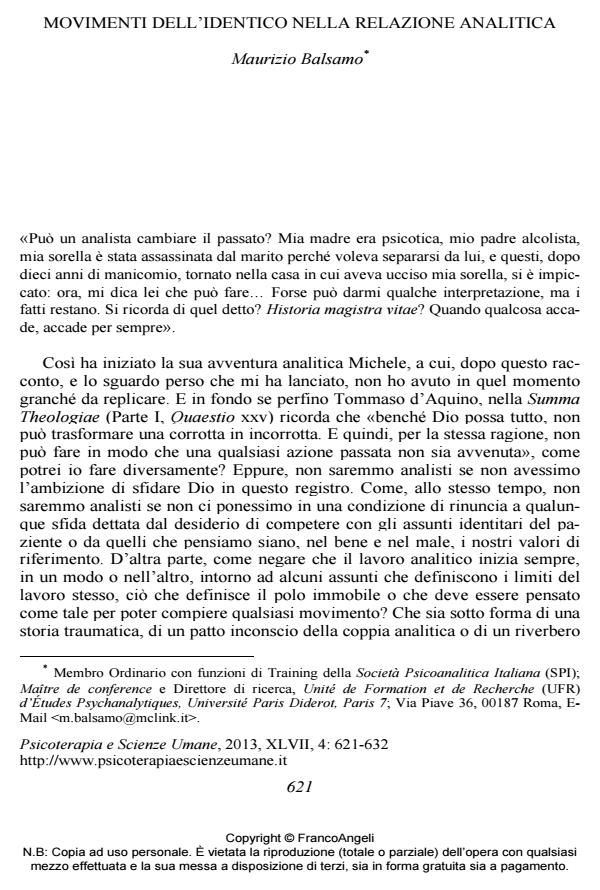Movements of the "identical" in the psychoanalytic relationship
Journal title PSICOTERAPIA E SCIENZE UMANE
Author/s Maurizio Balsamo
Publishing Year 2013 Issue 2013/4 Language Italian
Pages 12 P. 621-632 File size 82 KB
DOI 10.3280/PU2013-004003
DOI is like a bar code for intellectual property: to have more infomation
click here
Below, you can see the article first page
If you want to buy this article in PDF format, you can do it, following the instructions to buy download credits

FrancoAngeli is member of Publishers International Linking Association, Inc (PILA), a not-for-profit association which run the CrossRef service enabling links to and from online scholarly content.
The "identical" movement, that is, the need to find what has already been given, expresses a natural and spontaneous tendency of the psychic apparatus to establish, in this way, a continuity in the flow of transformation. However, this function assumes an autonomy from the regulatory processes, and ends up being a coactive and conservative mode, from its very beginning to the glaciations of each vital drive, in different psychopathological contexts, especially in the traumatic ones. The issue of how to enter this "cold" nucleus and how to provide different versions of the same narrative, allowing for the activation of the misidentification processes, is described through a clinical case in which the psychotic law of "all or nothing" finds its own modulation and definition.
Keywords: Identical, itself, transformation, misidentification, identity
- Laplanche J. (1997). Buts du processus psychanalytique. Revue Française de Psychanalyse, 61, 3: 1181-1194.
- Artaud A. (1927). Lettre à personne. In: OEuvres Complètes. Paris: Gallimard, 1976, Tomo I, vol. 2, pp. 55-56.
- Aulagnier P. (1984). Les deux principes du fonctionnement identificatoire: permanence et changement. In: Un interprète en quête de sens. Paris: Ramsay, 1986; Paris: Payot, 1991.
- Bollas C. (1989). Forces of Destiny. London: Free Association Books (trad. it.: Forze del destino: psicoanalisi e idioma umano. Roma: Borla, 1992).
- Bonaminio V. (2004). L’uso delle parole e la scrittura in Winnicott. Rivista di Psicoanalisi, 50S: 259-274.
- Freud S. (1912-13). Totem e tabù. Opere, 7: 3-164. Torino: Boringhieri, 1975.
- Freud S. (1937). Costruzioni nell’analisi. Opere, 11: 541-552. Torino: Boringhieri, 1979.
- Freud S. (1938 [1940]). Compendio di psicoanalisi. Opere, 11: 569-634. Torino: Boringhieri, 1979.
- Goethe J.W. (1808 [1831]). Faust e Urfaust. Milano: Garzanti, 1990.
- Guyomard P. (2009). Rien au centre. In: Aulagnier P. et al., La pensée interdite. Paris: PUF, 2009, pp. 75-90.
- Jabès E. (1963). Le livre des questions. Paris: Gallimard, 2006.
- Kafka F. (1917). Il silenzio delle sirene. In: Il messaggio dell’Imperatore. Milano: Adelphi, 1990.
- Kuhn T. (1962). The Structure of Scientific Revolution (2nd edition: 1970). Chicago: University of Chicago Press (trad. it.: La struttura delle rivoluzioni scientifiche. Torino: Einaudi, 1969).
- Lichtenstein H. (1977). The Dilemma of Human Identity. New York: Aronson.
- Lotman J. (1985). La semiosfera: l’asimmetria e il dialogo nelle strutture pensanti. Venezia: Marsilio.
- M’Uzan M. de (1977). Le même et l’identique. In: De l’Art à la Mort. Paris: Gallimard, 1977.
- M’Uzan M. de (2005). Aux confins de l’identité. Paris: Gallimard.
- Nancy J.L. (2010). Identités. Paris: Galilée.
- Winnicott D.W. (1959). Nothing at the centre. In: Psychoanalytic Explorations. London: Karnac, 1989, pp. 49-53 (trad. it.: Niente al centro. In: Esplorazioni psicoanalitiche. Milano: Raffaello Cortina, 1995, pp. 63-66).
- Wolfson L. (1970). Le schizo et les langues. Paris: Gallimard.
Maurizio Balsamo, Movimenti dell’identico nella relazione analitica in "PSICOTERAPIA E SCIENZE UMANE" 4/2013, pp 621-632, DOI: 10.3280/PU2013-004003